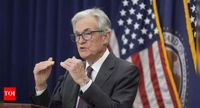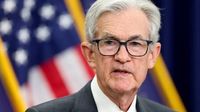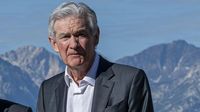Federal Reserve Chair Jerome Powell took center stage at the Jackson Hole Economic Policy Symposium on Friday, August 22, 2025, delivering a speech that investors, economists, and political leaders had been anxiously awaiting. The annual event, held in the scenic Wyoming resort town, has long been a bellwether for global monetary policy, and this year’s edition was no exception. As Powell spoke at 10:00 a.m. Eastern Time, financial markets hung on every word, searching for clues about the direction of U.S. interest rates and the central bank’s response to mounting economic and political pressures.
Powell’s address, titled “Labor Markets in Transition: Demographics, Productivity, and Macroeconomic Policy,” tackled the complex shifts underway in America’s workforce and economy. Recent labor data painted a mixed picture: only 73,000 new payrolls were added—far below expectations—with previous months’ numbers revised downward. The unemployment rate stood at 4.2%, but Powell pointed to deeper, structural changes reshaping the job market. Retirements, tighter immigration, and the rapid advance of AI-driven automation, he argued, are making the labor market function in new and unpredictable ways.
Markets were primed for Powell’s remarks, with Wall Street futures flashing cautious optimism ahead of the speech: Dow futures rose 0.34%, S&P 500 futures edged up 0.24%, and Nasdaq 100 futures ticked higher by 0.19% (as reported by The Economic Times). But the real question was whether Powell would signal a long-awaited rate cut at the Federal Reserve’s next policy meeting in September. Traders had been betting on a possible quarter-point reduction, with futures markets pricing in roughly 70% odds of easing—odds that had swung wildly in the days leading up to Jackson Hole as conflicting data emerged.
In his speech, Powell struck a careful balance. He acknowledged that “risks to inflation are tilted to the upside and risks to employment to the downside, a challenging situation when our goals, our intention like this, our framework calls for us to balance both sides of our dual mandate.” He went on to explain, “Our policy rate is now 100 basis points closer to neutral than it was a year ago, and the stability of the unemployment rate and other labor market measures allows us to proceed carefully as we consider changes to our policy stance.”
Powell stopped short of making any definitive promises about a September rate cut, but he did not rule it out. “Nonetheless, with policy in restrictive territory, the baseline outlook and the shifting balance of risks may warrant adjusting our policy stance. Policy is not on a preset course. FOMC members will make these decisions based solely on their assessment of the data and its implications for the economic outlook and the balance of risks, we will never deviate from that approach,” Powell said, echoing the Fed’s longstanding commitment to data-driven decision-making.
For traders, that was enough. The market’s reaction was swift and decisive: the Dow Jones Industrial Average surged more than 600 points, and 2-year Treasury yields fell 8 basis points to 3.71%, as investors bet that a rate cut was now firmly on the table for September. “Stocks are sniffing a dovish pivot, and Powell’s careful tone suggests the Fed’s bias may be leaning in that direction—even if he won’t say it yet,” noted James Hyerczyk, a veteran market analyst, in his post-speech commentary.
Powell painted a nuanced picture of the U.S. economy. He described the labor market as “in balance,” but clarified that it was a “curious kind of balance that results from a marked slowing in both the supply of and demand for workers.” This, he warned, means downside risks to employment are rising and could materialize quickly in the form of layoffs and rising unemployment. At the same time, GDP growth had slowed to 1.2% in the first half of 2025, about half the 2.5% pace seen in 2024, largely due to weaker consumer spending and slower growth in supply or potential output.
Powell also addressed the elephant in the room: political pressure. With his term set to end in May 2026, this was his final Jackson Hole appearance as Fed Chair. President Donald Trump has been anything but subtle in urging Powell and the Fed to accelerate rate cuts, repeatedly criticizing the central bank’s policies and even resorting to personal attacks. Trump has labeled Powell a “numbskull” and “moron,” and has not shied away from threatening personnel changes at the Fed, although he later walked back some of these threats. Most recently, Trump called for the resignation of Fed Governor Lisa Cook, citing unrelated allegations, which she firmly rejected, stating she had “no intention of being bullied to step down.”
Despite the political noise, Powell was adamant about the Fed’s independence. Without naming Trump directly, he emphasized, “Policy decisions will remain based solely on data.” He added, “There is significant uncertainty about where all of these policies will eventually settle and what their lasting effects on the economy will be.” Powell specifically cited the impact of Trump’s higher tariffs and tighter immigration rules, warning that “changes in trade and immigration policies are affecting both demand and supply in this environment. Distinguishing cyclical developments from trend or structural developments is difficult.”
Inflation, meanwhile, remains stubborn. Powell admitted that “inflation’s path is messy,” with ongoing risks from supply chain disruptions and tariffs. He reflected on the Fed’s 2020 pivot to “flexible average inflation targeting,” acknowledging that it was “challenged by the post-COVID inflation surge.” While the central bank isn’t abandoning its 2% target, Powell made clear that the Fed is “walking a tightrope” between supporting growth and containing price pressures. “We continue to believe that monetary policy must be forward looking and consider the lags its effects on the economy. For this reason, our policy actions depend on the economic outlook and the balance of risks to that outlook,” he said.
The stakes for Powell’s speech were high, and history shows why. Jackson Hole has often set the tone for market expectations and policy direction. Last year’s address triggered a two-day, 2% swing in the S&P 500, and this year’s speech had the potential to move trillions across stocks, bonds, and currencies. The immediate reaction—rising equities and falling yields—suggests that investors are positioning for a Fed pivot, even as Powell himself remains cautious.
Looking ahead, the Federal Reserve’s next policy meeting in mid-September looms large. The central bank has kept interest rates steady between 4.25% and 4.50% since December 2024, a stance influenced by both a resilient labor market and the inflationary impact of tariffs. Whether the Fed cuts rates next month will depend on incoming data—especially inflation and consumer spending figures. As Powell put it, “The Fed is not slamming on the brakes, but they’re easing off the gas—and the smart money is positioning for a turn.”
Powell’s final Jackson Hole speech as Fed Chair was a masterclass in central bank communication—measured, data-driven, and fiercely independent, even under the glare of political and market scrutiny. As the U.S. economy navigates shifting tides, Powell’s message was clear: the Fed will act, but only when the evidence compels it.


